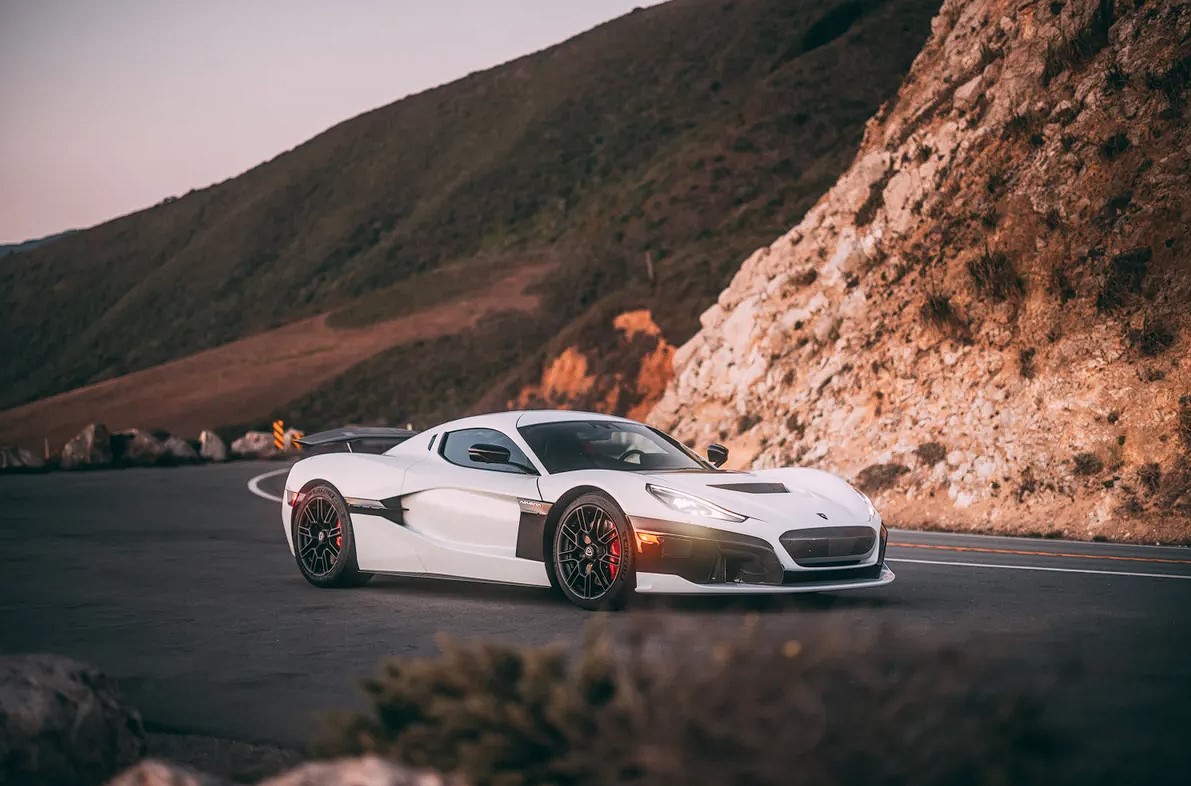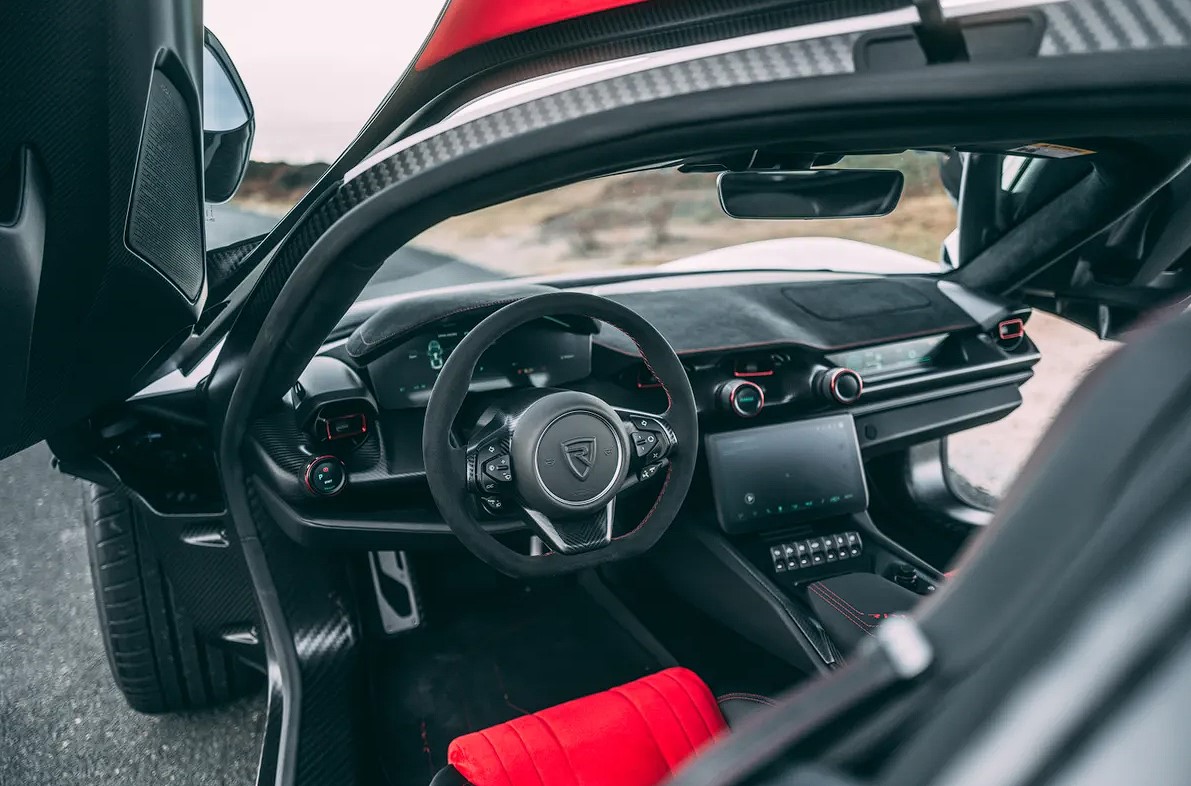2026 Rimac Nevera Specs, Redesign, Configurations – “When I say go, I want you to floor it and turn in hard.” I wouldn’t typically heed that type of driving advise while approaching a turn with a decreasing radius, particularly when there is a rock wall on one side and a high precipice on the other.
But I’m not just driving any car—I’m driving the Croatian electric hypercar, the 2026 Rimac Nevera, which is radically changing performance norms. My passenger, chief development driver Miro Zrnčević, advises me to push it halfway around the turn, even though I’ve never seen the Nevera accelerate out of a curve like this before.
Because it doesn’t require them, the Nevera doesn’t have conventional traction and stability control systems. Rather, it has the most remarkable torque-vectoring system available thanks to its four electric motors, one for each wheel. It can perform over 100 computations per second and is endlessly configurable. To optimize efficiency, it continuously modifies the output to each wheel. It facilitates powering out on departure, increases mid-corner stability, and enhances turn-in.
In addition, a progressive weighted rapid steering rack prevents me from losing control of the ride. According to Zrnčević, unless I deliberately try to slide the Nevera sideways in rear-drive Drift mode, it will never understeer or oversteer. The Nevera can corner far better than my head believes is possible and performs in a way that no other automobile can. 2026 Rimac Nevera Specs
2026 Rimac Nevera Redesign and Update Plan
Exterior & Interior
The Nevera weighs 4,740 pounds, yet it doesn’t seem quite as hefty as Rimac claims. Weighing less than 440 pounds, the structural battery pack, top, and rear subframe are the biggest single pieces of carbon fiber in the industry.
The Nevera’s weight balance of 48/52 front/rear and extremely low center of gravity, which is similar to that of a normal mid-engined supercar, are made possible by the T-shaped battery pack. The battery pack functions as an integral part and gives the monocoque tub 37% more structural rigidity. According to Rimac, the Nevera has passed every US crash test and is the stiffest production vehicle ever.
The design of the Nevera is arguably its least ridiculous feature. It’s a gorgeous hypercar, yet it stays inside reasonable bounds. Sharper lines, wider intakes, and more exquisite surfaces distinguish the overall design language from the 2013 Concept One.
The side vents, which resemble a classic Croatian military cravat necktie, are the most stylish features. For the best aerodynamics, the hood flap, underbody, rear diffuser, and rear wing are all moving and altering on their own. While the low-drag setting gives a reasonably flat drag coefficient of 0.3 and decreases drag by 17.5%, the high-downforce option boosts downforce by 326%.
Compared to many other hypercars, the Nevera’s interior is easier to reach through butterfly doors because to its thin carbon-fiber sills. While the front passenger gets a long horizontal screen that shows speed, power, and other information, the driver is met with a thin-rimmed steering wheel in front of a TFT digital gauge cluster and a bigger touchscreen that is slanted towards me.
The selection of gears, driving modes, and torque distribution are controlled by three rotary knobs with displays. Despite the straightforward overall appearance, there are a number of intriguing features, like a row of analog toggle switches, rectangular air vents, and many leather, carbon fiber, and billet aluminum embellishments.
The AI Driving Coach, which has twelve ultrasonic sensors, six radar modules, and thirteen cameras and is driven by Nvidia’s Pegasus operating system, is one function I am unable to test. By traveling a racetrack, the automobile can automatically determine the best driving and braking lines. Better yet, you can turn it on while you’re driving, and the AI coach will give you tips on how to speed up your laps. 2026 Rimac Nevera Specs
2026 Rimac Nevera Specs
Engine & Performance
After single-digit-number marketing for Concept One and Concept S, this is Rimac’s first serialized production model. The electric motors, the 120-kilowatt-hour battery pack, the carbon-fiber monocoque frame, and the software that manages everything were all designed, manufactured, and constructed by Rimac in-house. The two cars feel very different, even though Pininfarina purchased the engines and battery pack for its Battista hypercar from Rimac.
A notable 336 horsepower and 560 lb-ft more power than a Bugatti Chiron Super Sport is produced by the Nevera’s engines, which provide 1,914 horsepower and 1,740 lb-ft of torque. Additionally, it outperforms the Battista by 14 lb-ft and 37 horsepower. World-record acceleration is possible when the accelerator is depressed to the floor: The Nevera’s least impressive performance figure is 1.9 seconds, which is the time it takes to get from a halt to 60 mph.
Almost as long as it takes a Mercedes-Benz EQS580 to reach 60 mph, it takes 4.3 seconds to reach 100 mph. The Nevera is the fastest production automobile ever, reaching 186 mph in just.6 seconds once pinned and completing the quarter-mile at 167 mph in 8.6 seconds. It performs better than the original Bugatti Veyron, reaching a peak speed of 258 mph.
The acceleration of the Nevera is difficult to explain. As soon as the Nevera turns what’s left into a Jell-o puddle, my body immediately loses all of its oxygen. It is far more powerful than the gut punch that high-performance EVs are renowned for. My heartbeat quickens, my chest tightens, and my palms start to perspire.
It is simple to accelerate while already moving quickly or to launch from the line, though, in spite of the utterly ridiculous performance. Launches are made as rapid and smooth as possible via torque vectoring, which also removes tire slippage and the need to battle with the steering to retain control.
In addition, I can just put the car in track mode and floor it without the need for launch control. Chaining together small sections of mountain road soon becomes second nature as I become acquainted to the car’s capabilities and learn to look farther over the horizon than usual. After driving the Nevera, getting back into a Mercedes-AMG SL63 to head home is like getting into an original.
The Nevera has equal acceleration and deceleration. The Nevera’s most powerful regenerative braking system, which provides 300 kW of stopping power, allows it to decelerate at 0.4 g. The Nevera also has six-piston Brembo calipers and 15.3-inch carbon-ceramic brake discs in case the regen isn’t enough.
The necessary force is distributed between the electric motors and friction brakes using an electro-hydraulic brake booster. The car will utilize more physical brakes if the battery overheats, and more regen if the brakes overheat. Because of the simulated pedal sensation, the driver is oblivious to the changes, even though the braking is among the smoothest and most enjoyable I’ve encountered in an EV.
2026 Rimac Nevera Release Date & Price
An illustration of the potential performance of electric vehicles is the 2026 Rimac Nevera. The 150 fortunate buyers who are spending more than $2 million on a Nevera will receive the fastest automobile in the world, one that can defy the laws of physics and drive through a city center in luxury and silence without emitting any harmful pollutants. The absence of drama in the Nevera is, if anything, its biggest flaw.
There should be greater enthusiasm in the Nevera despite all the technical jargon. With less emphasis on actual driving enjoyment, its primary objective is to optimize a driver’s performance. But given how amazing and captivating the automobile is, that is a minor complaint.
It also offers a forecast for Bugatti, one of the top companies in the hypercar industry. The well-known French company is now a member of the Bugatti-Rimac joint venture, which is led by Mate Rimac, 34. In addition to its current offices in Molsheim, France, a new headquarters is being built in Croatia.
According to Rimac, the two businesses will continue to operate independently, with the main advantages being that Rimac will benefit from Bugatti’s current dealer network and production while Bugatti will use Rimac’s cutting-edge technology. I’m eager to see what Rimac can do with its first actual production project if this is the case.
Note: The details included in this blog post are derived from pre-release material that was accessible when the article was written. If you want the latest information, you should check official sources or call your nearest dealership.
Read Also:
- 2026 Nissan Sentra Review, Specs, Release Date
- 2026 Volkswagen Polo Specs, Price, Release Date
- 2026 Chrysler Airflow Price, Specs, Release Date
- 2025 Jeep Recon EV Specs, Price, Range
- 2025 Jeep Recon EV Specs, Price, Range



